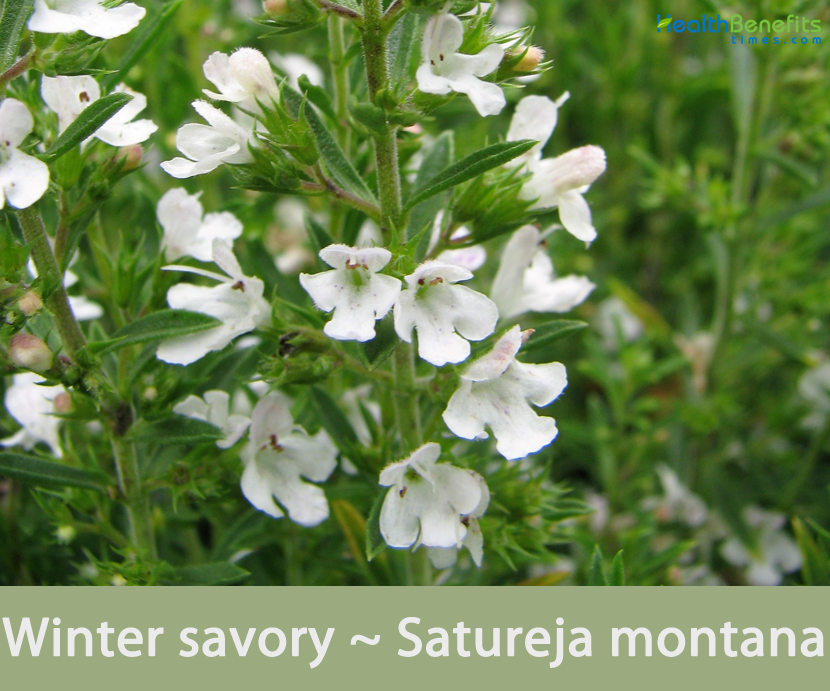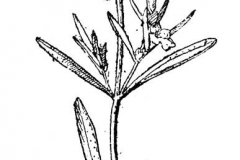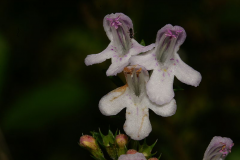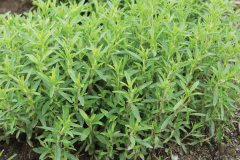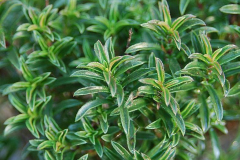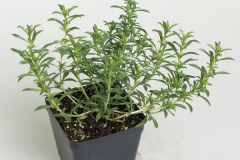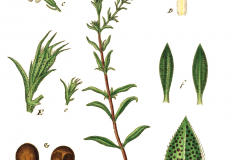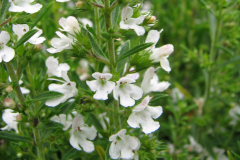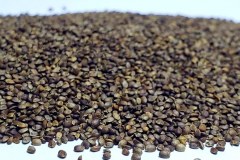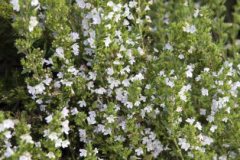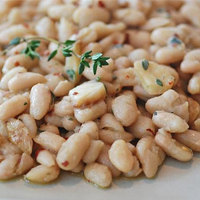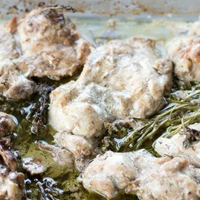| Winter savory Quick Facts | |
|---|---|
| Name: | Winter savory |
| Scientific Name: | Satureja montana |
| Origin | Warm temperate regions of southern Europe, the Mediterranean, and Africa |
| Shapes | 4 oval achene dotted with small grains |
| Taste | Pungent |
| Health benefits | Support for cramps, indigestion, diarrhea, nausea, intestinal gas, flatulence, gastro-enteritis, cystitis, bronchial congestion, sore throat and menstrual disorders |
| Name | Winter savory |
|---|---|
| Scientific Name | Satureja montana |
| Native | Warm temperate regions of southern Europe, the Mediterranean, and Africa. It has been naturalized in Great Britain since 1562 |
| Common Names | Winter savory, Savory, perennial savory, mountain savory |
| Name in Other Languages | Afrikaans: Wintergeur, Winter bonekruid Albanian: Dimër i këndshëm, trumzê Amharic: Kiremiti (ክረምት) Arabic: Malh alshita (مالح الشتاء), nadigh jabali (ندغ جبلي) Aragonese: Ajedrea, albaca montesina, sabiduria, saborija, sasculia, té de flor blanca, té de piedra Armenian: Dzmerrayin ktsu (ձմեռային կծու) Azerbaijani: Qış ləzzəti, Dağ kəkotusu Basque: Ajedrea, azitraia Bengali: Śītakālīna majādāra (শীতকালীন মজাদার) Bosnian: Vrijesak Bulgarian: Zimna chubritsa (зимна чубрица), Balkanska chubritsa (Балканска чубрица), Chubritsa balkanska (Чубрица балканска), Chubritsa planinska (Чубрица планинска), Chubritsa (Чубрица) Burmese: Saunggrarse aarasar (ဆောင်းရာသီအရသာ) Catalan: Sajolida, farigola, herba d’olives, hisopeta, jasolida, pedrerola, rosalia, saborija, sadurija, sajolida de bosc, sejalida Chinese: Dōngjì měiwèi (冬季美味), Shānxiāng bòhé (山香薄荷), Ōu xiāngliào (欧香料) Cornish: Sawor gwav Croatian: Zimska slana, Primorski vrisak, primorski čubar Czech: Zimní pikantní, Saturejka horska Danish: Vinter velsmagende, Vintersar, Winterbonenkruid Dutch: Hartige winter, Winter bonenkruid, doorlevend bonenkruid English: Winter savory, Savory, perennial savory, mountain savory, Esperanto: Vintra bongustaĵo, Monta satureo Estonian: Talvine soolane Filipino: Masarap na taglamig Finnish: Talvinen suolainen, Talvikynteli French: Pèbre d’ail, Poivre d’âne , Sarriette d’hiver, Sarriette des montagnes, Sarriette vivace, pèbre-d’ase, sarriette, savourée, Georgian: Zamtris kondari (ზამთრის ქონდარი) German: Winter herzhaft, Bergbohnenkraut, Winterbohnenkraut, Winter-Bohnenkraut, Bergkalaminthe, Bergsaturei, Karstbergminze, Winterbergminze Greek: Cheimóna almyró (χειμώνα αλμυρό), Thýmvra i oreiní (Θύμβρα η ορεινή), Gerontohorto (Γεροντόχορτο), Tragohorto (Τραγόχορτο), Tragorigane (Τραγορίγανη ) Gujarati: Śiyāḷāmāṁ svādiṣṭa (શિયાળામાં સ્વાદિષ્ટ) Hausa: Savory hunturu Hebrew: חורף מלוחה Hindi: Sardee kee aahat (सर्दी की आहट) Hungarian: Borsikafű, Hegyi pereszlény Icelandic: Vetur bragðmiklar Indonesian: Gurih musim dingin Irish: Blasta sa gheimhreadh Italian: Salato d’inverno, Santoreggia Montana, santoreggia, santoreggia selvatica Japanese: Fuyu no fūmi (冬の風味), Mauntenseiborī (マウンテンセイボリー) Javanese: Mangsa gurih Kannada: Caḷigālada khāra (ಚಳಿಗಾಲದ ಖಾರ) Kazakh: Qısqı dämdi (қысқы дәмді) Korean: Gyeoul pungmi (겨울 풍미), gyeoulseibeoli (겨울세이버리) Kurdish: Zivistanê savar Lao: Savory ladunav (savory ລະດູຫນາວ) Latin: De venatione hiems Latvian: Ziemas pikanti Lithuanian: Ziemos pikantiškumas Macedonian: Zimski soleni (зимски солени), Планинска чубрица Malagasy: Sakafo matavy amin’ny ririnina Malay: Gurih musim sejuk Malayalam: Sītakāla rucikaramāya (ശീതകാല രുചികരമായ) Maltese: Xitwa msaħħna Marathi: Hivāḷā rasa (हिवाळा रस) Mongolian: Ovliin amttai (өвлийн амттай) Nepali: Jāḍō pyādā (जाडो प्यादा) Norwegian: Vinter velsmakende, Vintersar Occitan: pebre-d’ase, isòp, sadreia, sagriéga, sariéte, sarrious, èrba de sentor, èrba fina Oriya: ଶୀତଦିନିଆ Pashto: د ژمي خوندور Persian: مریم زمستانی Polish: Cząber zimowy, Cząber górski Portuguese: Saboroso inverno, Segurelha , Segurelha-das-montanhas, Segurelha-de-inverno, Segurelha-de-verão, Segurella Punjabi: Saradī āṁ dī khurāka (ਸਰਦੀਆਂ ਦੀ ਖੁਰਾਕ) Romanian: Iarna savuroasa Russian: Pikantnyy zimniy (пикантный зимний), Chaber zimnii (Чабер зимний ), Chaber gornyy (Чабер горный), chabrets gornyy (чабрец горный) Serbian: Slane zimske (слане зимске), Čubrić, Vresak krÅ¡ki, Rtanjski čaj (Ртањски чај), brdski čubar (брдски чубар), bresina (бресина), vrijesak (вријесак) Shambala: Rtanjski čaj Sindhi: سياري جو مزو Sinhala: Sīta rasayi (ශීත රසයි) Slovakian: Saturejka vytrvalá, saturejka horská, štubrik horský, Slovenian: Zimski slain, KraÅ¡ki Å¡etraj, kraški šetraj Spanish: Salado de invierno, Ajedrea, Ajedrea de monte, Ajenjo, Hisopillo, Tomillo real, Kraški šetraj, ajedra, ajedrea común, ajedrea de montaña, ajedrea montesina, ajedrea salvaje , ajedrea silvestre, albaca montesina, boja, hierba de las tripas, jedrea, morquera, sabiduría, saborea, saborija, salseta, salseta d’Alcaná, salseta de pastor, sasculia, tomillo real, té blanco, té de flor blanca, té de piedra Sundanese: Usum tiris Swedish: Vintern salta, Vinterkyndel Tajik: Savory zimiston (savory зимистон) Tamil: Kuḷirkāla cuvaiyāṉatu (குளிர்கால சுவையானது) Telugu: Śītākālapu rucikaramaina (శీతాకాలపు రుచికరమైన) Thai: Vdū h̄nāw p̄hĕd (ฤดูหนาวเผ็ด) Turkish: Kış kokulu, Dağ geyik otu, Dağ sateri Ukrainian: Zymovyy pikantnyy (зимовий пікантний), Чабер гірський Upper Sorbian: Hórska poprica Urdu: موسم سرما کی بچت Uzbek: Qish mazali Vietnamese: Món mặn mùa đông Welsh: Sawrus gaeaf, Safri, Safri Fach, Sewyrllys Zulu: Isidlo sasebusika |
| Plant Growth Habit | Low-growing, woody-stemmed, somewhat-shrubby, spreading herbaceous perennial plant |
| Growing Climates | Old walls, dry banks, rocks on hillsides, rocky mountain slopes and on calcareous or alkaline soils |
| Soil | Appreciate fertile, alkaline to neutral soil but is not very picky. It can be cultivated in a low planter with perfect drainage |
| Plant Size | Can reach 6 to 12 inches in height and 8 to 12 inches in width |
| Stem | Stems are woody at the base, more or less tetragonal, erect, pubescent for short back hairs, usually widely branched from the bottom, so as to form a small bush |
| Leaf | Leaves are bright green, opposite, subsessile, very spaced on the stem, with entire, linear-lanceolate, sharp apex often folded downward, coriaceous, edged with small cilia, with scattered glands and with central nerve evident in the face inferior, and with a bundle of 2-8 leaflets in the axilla |
| Flowering season | July to October |
| Flower | The flowers appear in summer, between July and October, and range from pale lavender or pink to white. The flowers are smaller than summer savory flowers. It contains carvacrol, a monoterpenoid phenol |
| Fruit Shape & Size | Schizocarp: microbasario (tetrachenium) formed by 4 oval achene dotted with small grains |
| Propagation | From seeds, from cuttings and divisions of root |
| Taste | Pungent |
| Plant Parts Used | Flowering tops, essential oil |
| Lifespan | More than 2 years |
| Places to Grow |
|
| Season | August to October |
Plant Description
Winter savory is a low-growing, woody-stemmed, somewhat-shrubby, spreading herbaceous, perennial plant that normally can reach 6 to 12 inches in height and 12 to 24 inches in width. The plant is found growing in old walls, dry banks, rocks on hillsides, rocky mountain slopes and on calcareous or alkaline soils. Normally plant appreciate fertile, alkaline to neutral soil but is not very picky. It can be cultivated in a low planter with perfect drainage. Stems are woody at the base, more or less tetragonal, erect, and pubescent for short back hairs, usually widely branched from the bottom, so as to form a small bush.
Leaves
The leaves are leathery, bright green, opposite, sub-sessile, 1–2 cm long and 5 mm broad, very spaced on the stem, with entire, linear-lanceolate, sharp apex often folded downward, coriaceous, edged with small cilia, with scattered glands and with central nerve evident in the face inferior, and with a bundle of 2-8 leaflets in the axilla.
Flower
The flowers are hermaphroditic, perfumed, they are arranged in verticillastri of 2-3 to the axilla of the upper leaves supported by peduncles of 3-4 mm, have bracts and similar bracts but smaller than the leaves. The tubular calyx with 10 nerves ends with 5 triangular and pointed teeth more or less equal. The hairy-glandular corolla, white, mauve or pinkish white, is divided at the apex of the tube that protrudes from the calyx, in two lips, the upper one whole and erect while the lower trilobate, perpendicular to the tube and with the median lobe, oblong wider than side; 4 stamens, bifid stylus. The flowers appear in summer, between July and October. The flowers are smaller than summer savory flowers and consist of carvacrol, a monoterpenoid phenol.
Fruit
The fruit is housed inside the calyx and is a schizocarp: microbasario (tetrachenium) formed by 4 oval achene dotted with small grains. The anthesis is in the period between July and September.
Health benefits of Winter savory
Listed below are some of the popular health benefits of using Winter savory
1. Anti-septic and Anti-fungal
Leaves of Winter savory have been found to consist of medicinal essential volatile oils like carvacrol and thymol. Thymol is an anti-septic and anti-fungal agent, making it a great way to fight and prevent the spread of fungal infections. Carvacrol, meanwhile, is an antibacterial agent, effective in fighting such bacterial strains as Bacillus cereus and E coli.
2. Vitamins and Minerals
Rich in vitamins and minerals, Winter savory has been found to help keep the body up and running. Savory consists of potassium, which is essential to moderate blood pressure and keep the heart healthy. Iron content in savory encourages the development of blood cells, while zinc and vitamin C helps boost the immune systems.
3. Prebiotic and rich in fiber
Winter savory is a source of dietary fiber. It’s important to get sufficient fiber to keep your digestive system running smoothly. Fiber is also essential to helping reduce bad LDL cholesterol while helping to boost good HDL cholesterol. Fiber is also an important prebiotic that helps nurture good gut flora.
4. Digestive Aid
When consumed as a tea, it is a sovereign remedy for digestive upset, headaches, colic, flatulence, whilst it is also used to treat gastro-enteritis, cystitis, nausea, diarrhea, bronchial congestion, sore throat and menstrual disorders. Due to its antiseptic properties, drinking Winter savory tea may help improve the functioning of the liver and kidneys.
5. Fights Inflammation
In its concentrated oil form, the powerful medicinal effects of Winter savory oil may help treat rheumatism, gout, headaches, and nausea.
Traditional uses and benefits of Winter savory
- Winter savory is most often used as a culinary herb, but it also has marked medicinal benefits, especially upon the whole digestive system.
- Winter savory has a stronger action than the closely related summer savory, S. hortensis.
- The whole herb, and especially the flowering shoots, is mildly antiseptic, aromatic, carminative, digestive, mildly expectorant and stomachic.
- When taken internally, it is said to be a sovereign cure for colic and a cure for flatulence, whilst it is also used to treat gastro-enteritis, cystitis, nausea, diarrhea, bronchial congestion, sore throat and menstrual disorders.
- The plant is harvested in the summer when in flower and can be used fresh or dried.
- The essential oil forms an ingredient in lotions for the scalp in cases of incipient baldness.
- An ointment made from the plant is used externally to relieve arthritic joints.
- Winter savory works as an appetizer and increases the urge of eating.
- Winter Savory is carminative in nature and treats digestive disorders.
- Winter savory is good for diarrhea and sore throat.
- Winter savory tea cures menstrual cramps and associated pain.
- It helps you to get relief from cold and cough.
- Winter savory helps to fight infections and inflammation.
- The paste of leaves is applied topically over the affected area to get fast relief from Insect Stings.
- It helps in treating colic and flatulence.
- Rubbing a sprig of leaves on insect bites and stings from bees and wasps is said to provide immediate pain relief.
- People take winter savory for intestinal disorders including cramps, indigestion, diarrhea, nausea, and intestinal gas.
- They also take it to treat cough and sore throat, reduce sex drive, and as a tonic.
- It reduces and cures flatulence, gastro-enteritis, cystitis, nausea, diarrhea, bronchial congestion, sore throat and menstrual disorders.
- Essential oil that is extracted from the plant can be used on bald head.
- It is occasionally used as a remedy for a sore throat and bacterial infections.
- It is also used to treat lung ailments, like asthma and respiratory tract problems.
- Winter savory tea help to treat several internal disorders like tuberculosis, uterine contractions, coughs, gastric problems, colic, urine retention to even headaches.
- It is used for centuries in traditional medicine of Balcanic people in the healing of the lymphatic nodule and respiratory system inflammation.
- Essential oil of winter savory can be used in treatment of nausea, sore throat, rheumatism, gout, colic and flatulence.
- Tea made of winter savory can be used in treatment of uterine contractions, menstrual irregularities, cough, gastric problems, as well as disorders of kidney and liver.
Culinary Uses
- Leaves can be consumed raw or cooked.
- They are used mainly as a flavoring for cooked foods, especially beans, and also as a garnish for salads etc.
- The leaves can be used fresh or dried.
- Herbal tea is made from the fresh or dried leaves.
- The leaves are harvested just before the plant comes into flower.
- In cooking, winter savory has a reputation for going very well with both beans and meats, very often lighter meats such as chicken or turkey, and can be used in stuffing.
- It can also be used in soups and sauces.
- It has a strong flavor (more than summer savory), while uncooked but loses much of its flavor under prolonged cooking.
- It can be added to breadcrumbs, as a coating to various meats including trout.
- Leaves used to flavor meat, fish, salads, soup, stew, and sausage.
White Beans with Winter Savory and Sage
Ingredients
- 2 cans cannelini beans
- 1 bay leaf
- 2 fresh winter savory sprigs
- 10 fresh sage leaves
- 1 medium yellow onion, cut into 1/2 inch pieces
- salt and pepper
- 3 garlic cloves, finely chopped
- 1/3 cup dry white wine
- 1/2 teaspoon parsley
Directions
- Put the beans into a saucepan with the bay leaf, savory and two of the sage leaves.
- Warm gently until you need them, so that they take in the herb flavors. Remove the herbs and bay leaf, leave the beans in their broth.
- While the beans cook, chop the remaining sage leaves.
- Saute the onion with a little water, 1/2 teaspoon salt, and a few pinches of pepper.
- Saute over medium heat until the onion begins to release its juices.
- Add the garlic and sage; saute for about 10 minutes, then add the wine and cook for a minute or two, until the pan is nearly dry.
- Add the beans and their broth to the onions along with 1/2 teaspoon salt and a few pinches of pepper.
- Lower the heat and cook for 20 minutes, adding a little water if needed to keep the beans saucy.
- Add salt and pepper to taste. Add the parsley just before serving.
Balsamic Herb Baked Chicken Thighs
Ingredients
- 1-1.5 pounds chicken thighs, get the freshest chicken
- 3 fresh rosemary sprigs
- 5-9 sprigs dried (or fresh) Winter Savory herb
- 3 leaves fresh sage, chopped
- 1/4-1/2 cup olive oil, the more oil you use, the more juice you will have for serving
- 1-2 tablespoons Balsamic vinegar
- 1 teaspoon Kosher salt, or amount to taste
- 1/4-1/2 teaspoon fresh ground pepper medley, or amount to taste
- 1 teaspoon (1 large clove) minced garlic, optional
- lemon wedges to spritz for serving, optional
Directions
- In a baking dish mix all the marinade ingredients and coat the chicken thighs in it.
- Marinade chicken for at least a half-hour before cooking; you can also marinate for a few hours or overnight (8 hours).
- The chicken thighs will only taste better the longer it is marinated.
- When the chicken thighs are done marinating, bake in a 350 degree F oven for 25-35 minutes.
- You can turn once halfway through. Allow cooling 5 minutes before serving. Enjoy!
Other Facts
- The growing plant repels insects.
- An essential oil is obtained from the leaves.
- Plants can be grown as a ground cover when spaced about 45 cm apart each way.
- It is a good bee plant.
- The leaves have an aromatic fragrance.
- It is a good companion plant to grow in the garden; it does especially well with onions and beans and helps to repel insect pests.
- Winter savory seeds can prevent the germination of nearby seeds.
- It is woodier and bushier than Summer Savory.
- It is used as a companion plant for beans, keeping bean weevils away, and also plant with roses, reducing mildew and aphids.
- The leaves may be dried and use in pot pourii.
Precautions
- Avoid use during pregnancy and breastfeeding.
- Do not use in children under 7.
- Do not use in the person allergic to one of the components (limonene, linalool).
- Do not use in asthmatics without the advice of an allergist.
- Do not use in the epileptic people or people with a history of convulsive disorders.
- Do not use in people with a history of gastritis, peptic ulcer, viral hepatitis A, B or C, or liver failure.
References:
http://www.theplantlist.org/tpl1.1/record/kew-185794
https://www.itis.gov/servlet/SingleRpt/SingleRpt?search_topic=TSN&search_value=505016#null
https://www.botanical.com/botanical/mgmh/s/savwin25.html
https://pfaf.org/user/Plant.aspx?LatinName=Satureja+montana
https://www.cabi.org/isc/datasheet/116916
https://en.wikipedia.org/wiki/Winter_savory
https://gd.eppo.int/taxon/STIMO
https://plants.usda.gov/home/plantProfile?symbol=SAMO6
https://www.missouribotanicalgarden.org/PlantFinder/PlantFinderDetails.aspx?taxonid=281431


